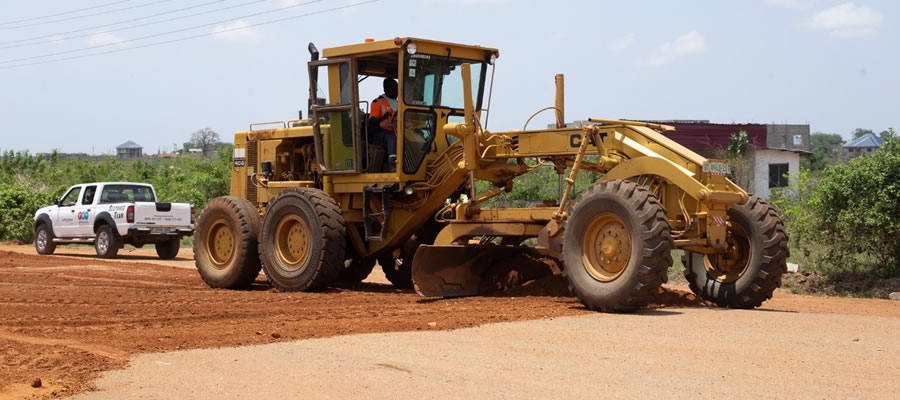

Health
The Municipality has access to both private and public health facilities. Table gives a description and statistics of the types of health facilities in the Municipality.
Apart from the above 26 health facilities, there are chemical and pharmaceutical shops that complement these facilities.
Since the Municipality is close to Tema, some referral cases are sent to the Tema General Hospital and also some people are able to assess it as their first point of call anytime they are sick. It should be noted that there is no ambulance service in the Municipality, so cases that are referred to Tema and its environs leads to untimely deaths of patients. Also in existence are herbal practitioners such as Dua ma Aduro-Sebrepor, Adom Herbal-Sebrepor, Abotare Clinic-Bethlehem, New Crystal Clinic-Kakasunanka among others, whose services also complement he above mentioned health facilities promote quality health care delivery by the Assembly.
The modern maternity block at the Kpone Health Center takes care of antenatal and postnatal services for the Kpone Community but the facility lack the necessary equipment to complement it. There is an Adolescent Reproductive Center in the Municipality that caters for Adolescent health. The Assembly has constructed a clinic at Zenu that is in use and there are two others at Gbetsile and Agbeshi Laryea respectively that is under construction as well as a CHPS compound at Saduase that is near completion.
All these facilities are expected to foster good health care delivery in the Municipality. It should however be noted that, the Municipality does not have a public hospital and therefore the Kpone Health Center in the Municipal Capital should be upgraded to a hospital status with the assistance from the Central Government, the Assembly and Corporate bodies to serve the entire Municipality efficiently.
Infant mortality in the Municipality is generally good as cases recorded over years have been very minimal. For instance, the infant mortality rates for 2016 and 2017 from both private and public health facilities were 0.81 and 0.56 per 1000 live births respectively. Some measures that have been put in place to facilitate the decrease in mortality rate included:
• The establishment of a pregnancy school in the municipality.
• Increase in health education on the care for babies.
• Increase in education of parents on nutrition for infants and young child.
• Distribution of Long Lasting Insecticide Treated Mosquito Bed Nets (LLITMBN).
Incidence of Diseases
The Table below indicates the trend of occurrences of diseases in the Municipality.
Table 1.22 highlights the ten top diseases from 2014 to 2017. Malaria topped the list in 2014 and 2015 and in 2016 and 2017. Upper Respiratory Tract Infections was the first on the chart as the reported disease at OPD followed by other sanitation and environmental diseases. It will however be realized that the sanitation and environmental related diseases are predominant among the first five diseases reported at OPD. This implies that activities geared toward addressing the problems of environmental can go a long way to positively influence the health status of residents of the Municipality.
Staffing
The table below shows the current staff strength of the Municipality
The table above indicates that, the entire Municipality has only one doctor and three physician assistants. This situation is the same as the year 2016 and is not the best. Cases are still being referred to Tema General Hospital and other health facilities for further attention. The Municipal Health Center needs to be upgraded to a hospital to meet the Municipality status it has acquired to attract more doctors and other medical staff to make it more efficient.
Currently, the health center serves as an office for the Health Directorate; this is not good as staff and patients are struggling for that small space.
From table 1.24, it can be implied that in the year 2016, the one medical doctor that the Municipality has attends to 126,625 patients. This is extremely alarming since it falls far above that of the country’s ratio (1:10,452) as well as the recommendations of the World Health Organization (WHO) and the Commonwealth, which are 1 doctor to 1,320 patients and 1 doctor to 5,000 patients, respectively. This clearly shows that, the services of the doctor is overstretched and could lead to unfortunate incident in the Municipality. If this persists, it will lead to a disaster in the Municipality. Hence, urgent and drastic measures must be put in place to curb this situation, to decrease significantly the number of patients to a doctor, to improve health care delivery in the Municipality.
It can also be realized that each nurse attends to 4,085 patients in the Municipality. This, like the doctor-patient ratio, is alarming since it falls to about three times above that of the country (1:1,251). This situation must also be treated with urgency so as to address this issue, to prevent any disaster in the Municipality as well as to promote health care delivery in the Municipality.
HIV/AIDS
The Kpone Katamanso Municipal Assembly with the Kpone Health Centre as the major Public Health facility in the Municipality, over the years has been without ART Centre. With the effort of the Municipal Health Director, the ART Centre has been established and is running effectively.
There are HIV/AIDs testing services at 16 Health facilities within the Municipality. According to a report from the Health Directorate and the HIV Focal Person, since 2014, over 3000 persons have been tested over the period out of which 195 persons have been reactive to the disease. The HIV prevalence rate in the Municipality is alarming, hence various sensitization programs, HIV Testing Services (HTS), Community Strengthening System, work place policy, in-school and out of school programs for the youth and various exercises are organized to help control the disease.
There are numerous challenges impeding the various intervention exercises as follows:
a) Inadequate funds on the part of the Assembly and the Health Directorate to carry out the
activities
b) Lack of funds for patients to carry out basic laboratory test to enable them enroll into the
ART medication
c) No CD4 count machine at the ART Centre.
HIV positive cases is shown in the table below:
Table 1.25 above indicates the trend of HIV/AIDS in the Municipality. It can be deduced from the table that the reported cases of HIV/AIDS is on the ascendancy in the Municipality from 2016 to 2017 and the most affected are the females. This can be attributed to the fact that women are more vulnerable than men.
Health Insurance Scheme
The Municipality does not have a Health Insurance Scheme. The Tema Health Insurance Scheme has oversight responsibility in the Municipality. In other words, the inhabitants of Municipality depend on Tema for such a service. This can be frustrating sometimes because one has to travel to Tema for this service. That notwithstanding, OPD attendance with National Health Insurance is indicated in the table 1.25 below:-
From Table 1.26, it can be said that, a lot of people in the Municipality depend on this service to access health facilities (both private and Public). It will therefore be prudent if the National Health Insurance Authority will consider giving the Municipality its Scheme to make it more accessible to its inhabitants. The OPD insurance status is translated in the figure below.
Infant Mortality Rate:
The Municipality has no record of infant death because it does not have a hospital.
Challenges of the Municipal Health
The Health Directorate is faced with the following challenges:
a) Lack of Municipal hospital to further manage referred cases
b) Lack of permanent office facility for DHMT
c) Inadequate staffs
d) Lack of cold room
e) No ambulance service in the Municipality
f) Poor cooperation by some private health providers
g) Under reporting of notifiable conditions by some private health providers
h) Inadequate number of computers and other logistics.
The Municipality has a number of public and private health facilities. These enable the residents to benefit from various government policies and interventions such as the free maternal healthcare, NHIS and other important healthcare policies being implemented in the country.
There are six public health centres, 19 CHPS Compound and one clinic. Currently, the Assembly is constructing two clinics under at Gbetsile and Agbeshie Laryea- Katamanso. These projects are funded by the DACF and are at appreciable levels of completion. The efforts of the private sector cannot be neglected as they are also supporting significantly with health care delivery in the Municipality. There are six private hospitals, six clinics and three maternity homes.
Despite the presence of these facilities, the Municipality cannot boast of a Municipal hospital, hence, referral cases are sent to other hospitals outside the Municipality. Residents close to major or tarred roads also access clinics or hospitals of their choice outside the Municipality. The health facilities in the Municipality render services like laboratory, pharmacy, family planning, reproductive and child health and maternal services to the people of the Municipality.
With the establishment of Area Councils, there is an urgent need to identify and upgrade health facilities within these Area Councils to provide services to the people in the catchment areas. In line with this, the Assembly has built a clinic for Zenu and it’s operational. This is to serve ZEKAS Area Council as well as CHPS compound to complement it. The Assembly is again constructing 2 clinics at Gbetsile and Agbeshie Laryea- Katamanso for KAMSBEG and ZEKAS Area Councils respectively. A CHPS compound has been constructed at Saduase to Serve Saduase and its environs in the ONSBAC Area Councils. This CHPS compound is yet to be put into operation awaiting the supply of the needed furniture and equipment. There is also the construction of a health Post at Saki in the KAMSBEG Area Council that is ongoing to meet the health needs of the people there.
It is clear that the Assembly is putting in a lot of efforts to bridge access to health facilities but there is still more to do in this regard that is by providing more health facilities (clinics, CHPS etc.) and the ones under construction provisions should be made for equipment and furniture to put them into use immediately after completion.
As a growing Municipality there is the need to have its own ambulance for emergency cases, hence, an urgent need for the Municipality to procure a modern ambulance for referral cases. There are a number of chemical and pharmacy shops in the Municipality. Residents with minor illness resort to these shops for drugs. Almost all the communities in the Municipality have access to chemical and pharmaceutical shops. This prevents long travel to distant places for first aid drugs.
The Base Map of the Health, show the health facilities in the Municipality which serves as the base line for the desired future.
Date Created : 4/25/2023 12:00:00 AM












 facebook
facebook
 twitter
twitter
 Youtube
Youtube
 +233 593 831 280
+233 593 831 280 0800 430 430
0800 430 430 GPS: GE-231-4383
GPS: GE-231-4383 info@ghanadistricts.com
info@ghanadistricts.com Box GP1044, Accra, Ghana
Box GP1044, Accra, Ghana